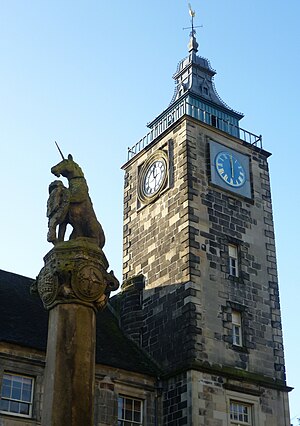
Back Guerra Radical Spanish 1820ko Eskoziako insurrekzioa Basque Insurrezione scozzese del 1820 Italian
| Radical War | |||
|---|---|---|---|
 | |||
| Date | 1–8 April 1820 | ||
| Location | Western Central Scotland | ||
| Caused by |
| ||
| Goals |
| ||
| Resulted in |
| ||
| Parties | |||
| |||
| Lead figures | |||
Non-centralised leadership
| |||
| Casualties | |||
| Charged | 88 charged with treasons Many leaders executed Absolute pardon granted on 10 August 1835 (15 years later) 20 radicals sentenced to penal transportation | ||
The Radical War, also known as the Scottish Insurrection of 1820, was a week of strikes and unrest in Scotland, a culmination of Radical demands for reform in the United Kingdom of Great Britain and Ireland which had become prominent in the early years of the French Revolution, but had then been repressed during the long Napoleonic Wars.
An economic downturn after the wars ended brought increasing unrest, but the root cause was the Industrial Revolution. Artisan workers, particularly weavers in Scotland, sought action to force the government to enact Luddite protective restrictions. Gentry fearing revolutionary horrors recruited militia and the government deployed an apparatus of spies, informers and agents provocateurs to stamp out the movement.
A Committee of Organisation for Forming a Provisional Government put placards around the streets of Glasgow late on Saturday 1 April, calling for an immediate national strike. On Monday, 3 April, work stopped in a wide area of central Scotland and, in a swirl of disorderly events, a small group marched towards the Carron Company ironworks to seize weapons, but, while stopped at Bonnymuir, they were confronted by a detachment of hussars. Another small group from Strathaven marched to meet a rumoured larger force, but were warned of an ambush and dispersed. Militia taking prisoners to Greenock jail were attacked by local people and the prisoners released. James Wilson of Strathaven was singled out as a leader of the march there, and was executed by hanging at Glasgow, then decapitated. Of those arrested by government troops at Bonnymuir, John Baird and Andrew Hardie were similarly executed at Stirling after making short defiant speeches. Twenty other Radicals were sentenced to penal transportation.
It was suspected that government agents had actively fomented the unrest to bring radicals into the open. The insurrection was largely forgotten as attention focused on better publicised Radical events in England. Two years later, enthusiasm for the visit of King George IV to Scotland successfully boosted loyalist sentiment, ushering in a new-found Scottish national identity.[1]
- ^ Prebble 2000, pp. 364–365